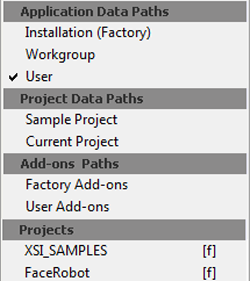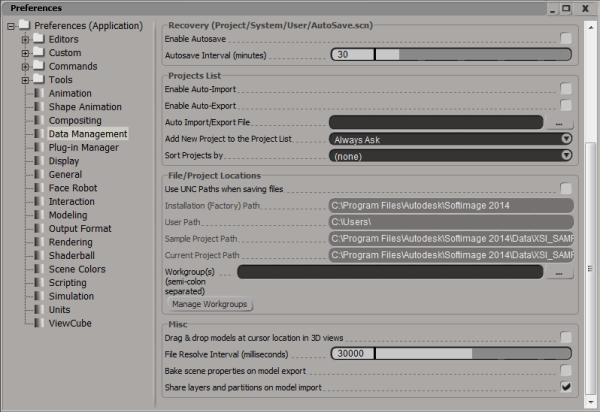After you write a script, you can save the contents in the editing pane as a script file. You can also open existing script files in the script editor.
Scripts are saved as plain text files with an extension that denotes the scripting language. For more information about the supported scripting languages, see Introduction to Scripting in Softimage.
Although, you can save script files anywhere, it is recommended that you use a standard location. This makes it easier to track your scripts, especially when editing and updating them. The default location is the Data\Scripts folder in your user path.
You can click the Paths button in the Open Script File and Save Script File dialog to choose different locations as shown in the following figure:

Installation (Factory) is the location where the Softimage program files are installed. Scripts saved here are available to any user on the local machine. You must copy these scripts if you install Softimage to a new location.
Workgroup lets you share scripts, presets, and other data with members of your team. To set a workgroup application path, select File  Preferences in the application menu bar and set the Workgroup(s) option in the Data Management preferences as shown in the following figure.
Preferences in the application menu bar and set the Workgroup(s) option in the Data Management preferences as shown in the following figure.

User is your user path. For example, C:\users\xyz\Autodesk\Softimage_<version>. You can access the scripts saved in this location whenever you log on as the same user.
Sample Project is a project that contains sample scenes included with Softimage. It is not recommended to save your scripts here.
Current Project is a project that contains the open scene. You can use this folder if your script is specific to a particular project.
Factory Add-ons is the Addons folder in the location where the Softimage program files are installed.
Other projects in your Projects List are listed under Projects.
There is a Scripts folder in each project. This is a good location to save a script file if it is specific to a particular project or scene, or if you want to make sure that the correct version of a script is stored with a project for archiving.
You can either save the entire contents of the editing pane or just the selected text.
To save the entire contents of the editing pane to the disk as a script file, do one of the following:
You must make sure to provide the correct file extension based on the language of the script.
To save the entire contents of the editing pane with a new name:
To save selected text as a script file:
You must make sure that the file extension is correct for the script language when saving files.
You can open a script file from the script editor's File menu, or by dragging and dropping. You can also open a script file that is registered as a custom command directly from its command button.
To open a script file from the File menu:
Do one of the following to display the Open dialog box:
If the current contents of the editing pane are not saved, you are prompted to save them.
Select a script file and click OK.
The contents of the script file appear in the editing pane. The name of the file is displayed in the script editor's title bar.
To open a script file by dragging and dropping:
Drag the script file from a browser view into the editing pane, or drag a link to the script file from net view. On Windows, you can also drag it from a folder window.
To open a script file that is registered as a custom command:
 Except where otherwise noted, this work is licensed under a Creative Commons Attribution-NonCommercial-ShareAlike 3.0 Unported License
Except where otherwise noted, this work is licensed under a Creative Commons Attribution-NonCommercial-ShareAlike 3.0 Unported License